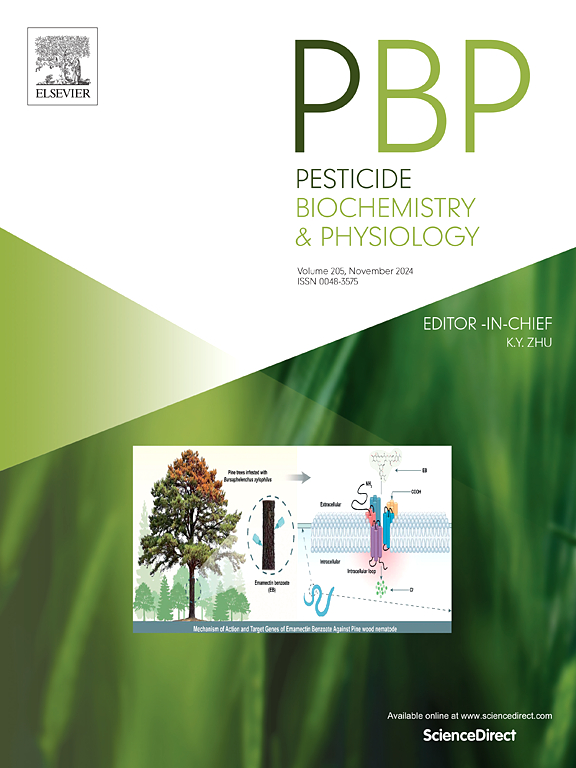Molecular characterization of Spodoptera frugiperda nose resistant to fluoxetine protein 6 and its putative involvement in tolerance to cyantraniliprole
IF 4
1区 农林科学
Q2 BIOCHEMISTRY & MOLECULAR BIOLOGY
引用次数: 0
Abstract
Spodoptera frugiperda (FAW) is a notorious polyphagous pest that has developed resistance to various insecticides including diamide insecticides. Our previous study established a FAW cyantraniliprole-resistant (SfCYAN-R) strain by laboratory resistance selection of susceptible strain (SfCYAN-S), however, the potential resistance mechanisms of FAW to cyantraniliprole remain unclear. In this study, SfNrf6 encoding nose resistant to fluoxetine (Nrf) protein 6 was identified to be upregulated in SfCYAN-R strain compared with SfCYAN-S strain based on RNA-Seq data and RT-qPCR. The cDNA of Nrf6 was 2094 base pairs in length and encoded a protein of 697 amino acids. Sequence analysis revealed that SfNrf6 contained the conserved Nrf domain as well as acyltransferase domain, and shared high amino acid identity with Bombyx mori homologue. RT-qPCR analysis revealed that SfNrf6 was highly expressed in the midgut, and was upregulated at 1 h and 2 h after exposure of the third instar larvae to cyantraniliprole. Notably, knockdown of SfNrf6 significantly increased the susceptibility of FAW to cyantraniliprole. Furthermore, cytotoxicity assay demonstrated that overexpression of SfNrf6 enhanced Sf9 cell viability under cyantraniliprole treatment. These results provided preliminary evidence that SfNrf6 was involved in cyantraniliprole tolerance in FAW, which had applied implications for FAW resistance management.

氟西汀蛋白6抗性狐尾蛾的分子特征及其与氰胺耐受性的关系
Spodoptera frugiperda (FAW)是一种臭名昭著的多食性害虫,对包括二胺类杀虫剂在内的多种杀虫剂产生抗药性。本研究通过对易感菌株SfCYAN-S的实验室耐药筛选,建立了一汽对氰氨酰胺耐药菌株SfCYAN-R,但一汽对氰氨酰胺的潜在耐药机制尚不清楚。本研究通过RNA-Seq数据和RT-qPCR分析,鉴定SfCYAN-R菌株中编码鼻抗氟西汀(Nrf)蛋白6的SfNrf6与SfCYAN-S菌株相比表达上调。Nrf6 cDNA全长2094个碱基对,编码697个氨基酸的蛋白。序列分析表明,SfNrf6具有保守的Nrf结构域和酰基转移酶结构域,与家蚕同源物具有较高的氨基酸同源性。RT-qPCR分析显示,SfNrf6在中肠高表达,并在暴露于三龄幼虫1 h和2 h后表达上调。值得注意的是,敲低SfNrf6显著增加了FAW对氰氨酰胺的敏感性。此外,细胞毒性实验表明,在氰氨酰胺处理下,SfNrf6的过表达增强了Sf9细胞的活力。这些结果为SfNrf6参与FAW对氰氨酰胺的耐受性提供了初步证据,对FAW耐药管理具有应用意义。
本文章由计算机程序翻译,如有差异,请以英文原文为准。
求助全文
约1分钟内获得全文
求助全文
来源期刊
CiteScore
7.00
自引率
8.50%
发文量
238
审稿时长
4.2 months
期刊介绍:
Pesticide Biochemistry and Physiology publishes original scientific articles pertaining to the mode of action of plant protection agents such as insecticides, fungicides, herbicides, and similar compounds, including nonlethal pest control agents, biosynthesis of pheromones, hormones, and plant resistance agents. Manuscripts may include a biochemical, physiological, or molecular study for an understanding of comparative toxicology or selective toxicity of both target and nontarget organisms. Particular interest will be given to studies on the molecular biology of pest control, toxicology, and pesticide resistance.
Research Areas Emphasized Include the Biochemistry and Physiology of:
• Comparative toxicity
• Mode of action
• Pathophysiology
• Plant growth regulators
• Resistance
• Other effects of pesticides on both parasites and hosts.

 求助内容:
求助内容: 应助结果提醒方式:
应助结果提醒方式:


